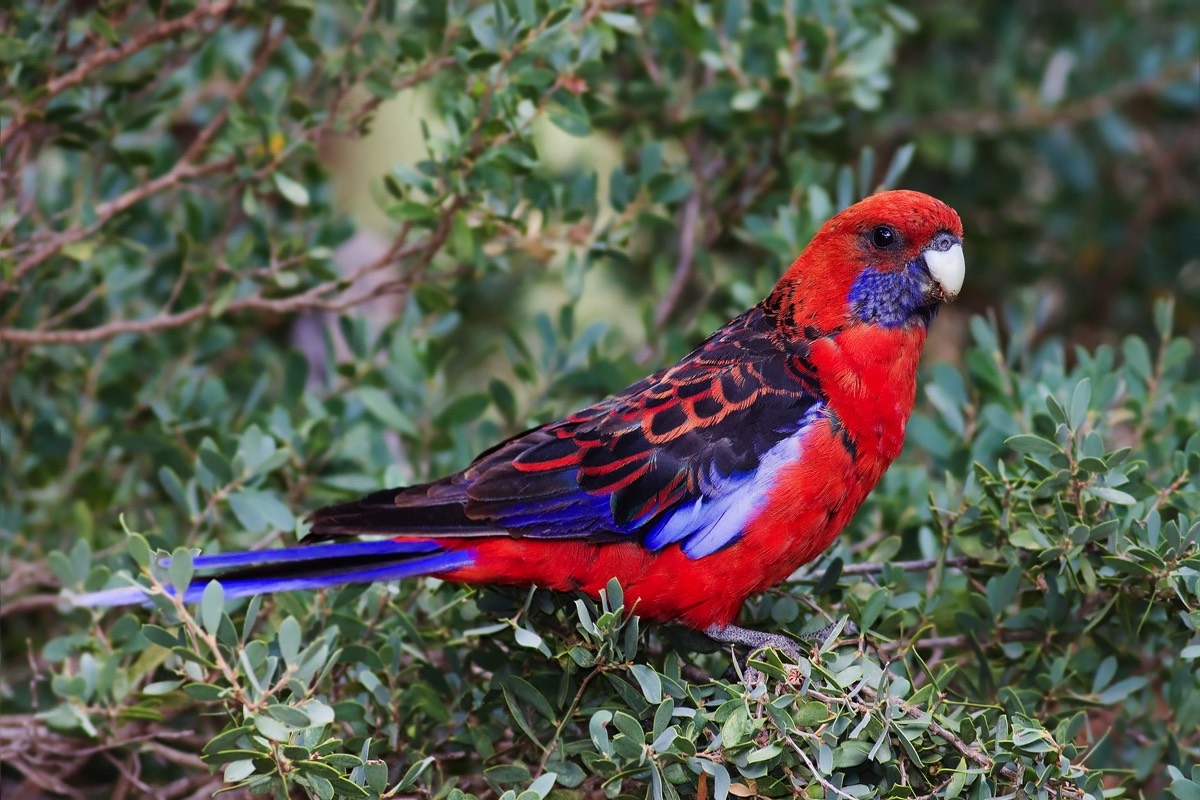Crimson Rosella - Platycercus Elegans - Least Concern
The crimson rosella (Platycercus elegans) is a parrot native to eastern and south eastern Australia which has been introduced to New Zealand and Norfolk Island. It is commonly found in, but not restricted to, mountain forests and gardens. The species as it now stands has subsumed two former separate species, the yellow rosella and the Adelaide rosella. Molecular studies show one of the three red-coloured races, P. e. nigrescens, is genetically more distinct.
Description: Platycercus elegans is a medium-sized Australian parrot at 36 cm (14 in) long, much of which is tail. There are seven subspecies, three of which are actually crimson. The red is replaced by yellow in the case of var. flaveolus and a mixture of red, orange and yellow in the Adelaide rosella.
Adults and juveniles generally show strikingly different colouration in south-eastern populations, with predominantly greenish-olive body plumage on the juvenile, most persistent on the nape and breast. Juveniles are said to 'ripen' as they get older and turn from green to red. All races have blue cheeks and black-scalloped blue-margined wings and predominantly blue tail with predominantly red coloration. The crimson rosella's blue tail feathers are one of the favourite decorations of the satin bowerbird. The bill is pale grey and the iris dark brown.
There is very little sexual dimorphism in crimson rosellas. The most noticeable difference between genders is that males are up to 15% larger, and have a relatively larger and wider beak.
Subspecies
P. elegans elegans, the nominate race of Victoria and eastern New South Wales. P. elegans nigrescens, occurring on Queensland's northeastern coast, and P. elegans melanoptera on Kangaroo Island. The main distinctions between these is size: nigrescens is the smallest of the three and melanoptera is the largest; both are slightly darker than the nominate race.
The juveniles of P. e. nigrescens lack the greenish immature plumage of the other subspecies of crimson rosella.
Yellow rosella: The yellow rosella, which lives along the Murray River and several of its tributaries, was reclassified (1968) as a subspecies, P. elegans flaveolus, of the crimson as the two were found to interbreed where their ranges overlap. The main difference between the two is that the crimson areas replaced with light yellow and the tail more greenish.[18]
Adelaide rosella: The Adelaide rosella of Adelaide and the surrounding area was also thought to be a separate species, but is presently believed to be a hybrid swarm, having originated through interbreeding of the crimson and yellow rosellas. Both of these still interbreed with the Adelaide rosella where its range crosses theirs, and it exhibits variation in its plumage from dark orange-red in the south of its distribution to a pale orange-yellow in the north. Variants that are very close to the yellow race are designated subadelaidae.
Distribution and Habitat: The crimson rosella occurs from southeastern South Australia, through Tasmania, Victoria and coastal New South Wales into southeastern Queensland. A disparate population occurs in North Queensland.
Around 1910, a small number of crimson rosellas were released off the Otago Heads, New Zealand, along with eastern rosellas. These interbred and by the 1950s no pure crimson rosellas remained. This mixed population has remained there ever since. Crimson rosellas were also present in Wellington City from 1963 through the early 1990s as an introduced species. Two crimson rosellas were also recorded from the Tararua foothills in 1971. It is now thought to be extinct in the wild in New Zealand.
Crimson rosellas were taken to Norfolk Island as cage birds during the first penal settlement. Escaping into the wild, they were reported before 1838, and have become numerous by 1900. There they are often known as "red parrots", to distinguish them from the native Norfolk Island parakeet or "green parrots".
Crimson rosellas are common in coastal and mountain forests at all altitudes. They primarily live in forests and woodlands, preferring older and wetter forests. They can be found in tropical, subtropical, and temperate rainforests, both wet and dry sclerophyllous forests, riparian forests, and woodlands, all the way from sea level up to the tree line. They will also live in human-affected areas such as farmlands, pastures, fire-breaks, parks, reserves, gardens, and golf-courses. They are rarely found in treeless areas. At night, they roost on high tree branches.

Psittaciformes, The Parrot Index, a part of Phoenix Feathers © 2016 - 2023
Page last updated: 12/24/23
Phoenix Feathers

